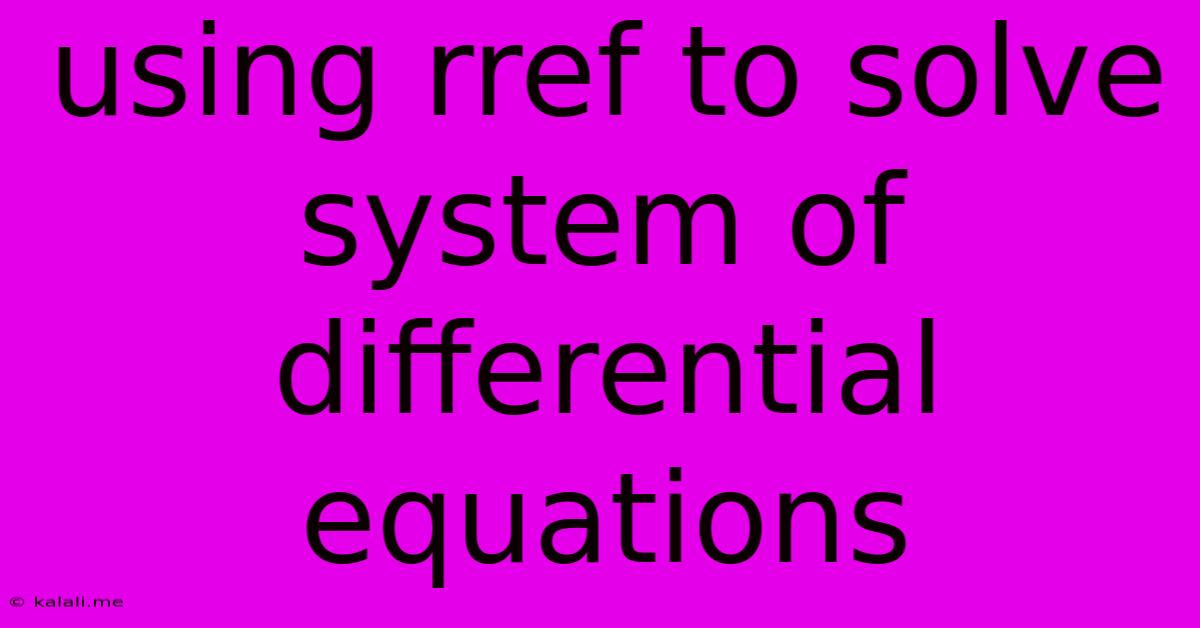Using Rref To Solve System Of Differential Equations
Kalali
Jun 02, 2025 · 4 min read

Table of Contents
Using RREF to Solve Systems of Differential Equations
This article explores how to leverage Reduced Row Echelon Form (RREF) to efficiently solve systems of linear differential equations. Understanding RREF provides a systematic approach, especially beneficial when dealing with larger systems where traditional methods become cumbersome. This method is particularly useful for finding the general solution, which subsequently allows for the determination of particular solutions given initial conditions.
What are Systems of Differential Equations?
A system of differential equations is a collection of two or more differential equations that involve the same unknown functions. These systems often model complex phenomena in various fields, including physics, engineering, and economics. A common type is a system of linear differential equations, where the unknown functions and their derivatives appear linearly. For example:
- dx/dt = 2x + y
- dy/dt = x - 3y
This system involves two unknown functions, x(t) and y(t), and their first derivatives.
The Power of RREF
Reduced Row Echelon Form (RREF) is a matrix simplification technique where a matrix is transformed into a specific form making it easy to solve linear equations. This same principle can be elegantly applied to solve systems of linear differential equations. The key lies in representing the system in matrix form and then using RREF to simplify the system before finding the solutions.
Steps to Solve Using RREF
Let's outline the steps involved in solving a system of linear differential equations using RREF:
-
Represent the System in Matrix Form: Rewrite the system of differential equations into a matrix equation of the form
dX/dt = AX, where:Xis a column vector of the unknown functions (e.g.,[[x], [y]]).Ais a coefficient matrix containing the constants from the differential equations.dX/dtrepresents the derivative of the vectorXwith respect tot.
-
Find the Eigenvalues and Eigenvectors of A: The next crucial step involves finding the eigenvalues (λ) and corresponding eigenvectors (v) of the coefficient matrix
A. This is done by solving the characteristic equationdet(A - λI) = 0, whereIis the identity matrix. Each eigenvalue will have an associated eigenvector. -
Construct the General Solution: The general solution is built using the eigenvalues and eigenvectors. For each eigenvalue λᵢ and its corresponding eigenvector vᵢ, a component of the general solution is given by:
e^(λᵢt) * vᵢ. The complete general solution is the linear combination of these components:X(t) = c₁e^(λ₁t)v₁ + c₂e^(λ₂t)v₂ + ... + cₙe^(λₙt)vₙwhere c₁, c₂, ..., cₙ are arbitrary constants.
-
Apply Initial Conditions (if given): If initial conditions are provided, substitute the initial values of
X(t)into the general solution to solve for the constants c₁, c₂, ..., cₙ. This yields the particular solution for the given initial conditions. This often involves solving a system of linear algebraic equations, potentially again using RREF for efficiency.
Example
Let's consider the example system:
- dx/dt = 2x + y
- dy/dt = x - 3y
-
Matrix Form:
[[dx/dt], [dy/dt]] = [[2, 1], [1, -3]] [[x], [y]] -
Eigenvalues and Eigenvectors: Finding the eigenvalues and eigenvectors of
[[2, 1], [1, -3]](we omit the detailed calculation here, which involves solving the characteristic equation and then solving for the eigenvectors). Let's assume (for the sake of example) we find eigenvalues λ₁ = 3 and λ₂ = -2, with corresponding eigenvectors v₁ =[[1], [1]]and v₂ =[[-1], [1]]. -
General Solution:
[[x(t)], [y(t)]] = c₁e^(3t)[[1], [1]] + c₂e^(-2t)[[-1], [1]] -
Particular Solution (with initial conditions): If we are given initial conditions, say x(0) = 1 and y(0) = 0, we can substitute t = 0 into the general solution and solve for c₁ and c₂. This would result in a particular solution.
Conclusion
Using RREF to solve systems of linear differential equations provides a structured and efficient approach, particularly useful when dealing with larger and more complex systems. By leveraging the power of matrix operations and the systematic nature of RREF, we can systematically determine the general and particular solutions, providing a clear path to understanding the dynamics of the system. Remember that finding eigenvalues and eigenvectors forms a critical part of this method. While computationally intensive for large systems, software packages can readily handle these calculations, allowing you to focus on the application and interpretation of the results.
Latest Posts
Latest Posts
-
I M Playing Chess You Re Playing Checkers
Jun 04, 2025
-
Bike Chain Making Noise When Pedaling
Jun 04, 2025
-
What Does It Mean For Women To Be In Purdah
Jun 04, 2025
-
Does Native American Grow Facial Hair
Jun 04, 2025
-
I Need To Question Why You Did This
Jun 04, 2025
Related Post
Thank you for visiting our website which covers about Using Rref To Solve System Of Differential Equations . We hope the information provided has been useful to you. Feel free to contact us if you have any questions or need further assistance. See you next time and don't miss to bookmark.